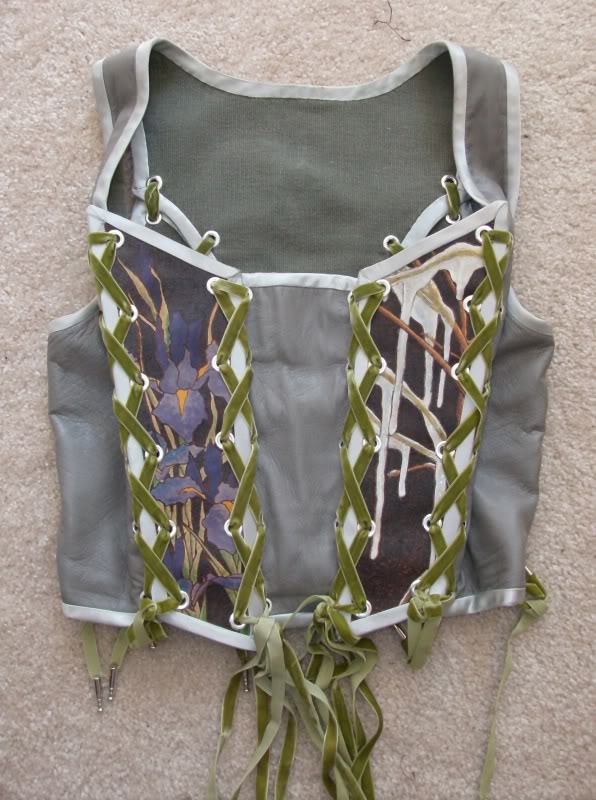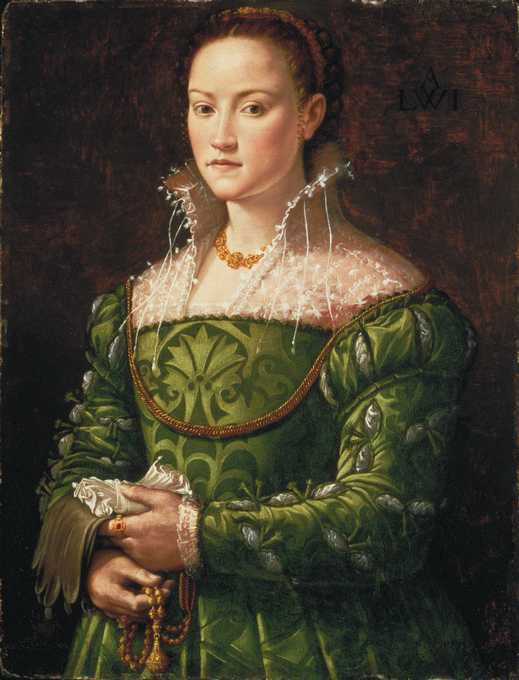Difference between revisions of "Bodice"
Weird Bird (talk | contribs) m (→In Amtgard: - removed a link to a page on renn faires that doesn't exist, and also updated it to a more common spelling of "Ren Faire".) |
|||
| (6 intermediate revisions by 3 users not shown) | |||
| Line 1: | Line 1: | ||
| − | [[File:Laced bodice by Casca.jpg| | + | [[File:Laced bodice by Casca.jpg|thumb|right|Laced bodice, by [[Casca]]]] |
| − | A bodice is an article of clothing for women, covering the body from the neck to the waist | + | A [[bodice]] is an article of clothing for women, covering the body from the neck to the waist. In common usage, bodice refers to an upper garment that has removable sleeves or no sleeves, often low-cut, worn in Europe from the sixteenth century to the eighteenth century, either over a [[corset]] or in lieu of one. To achieve a fashionable shape and support the bust, the bodice was frequently stiffened with reed or whalebone. |
| − | |||
| − | |||
| − | The | + | The bodice was also different from the corset of the time because of the way it laced: the corset was laced in spiral fashion, with one continuous lace; the bodice was laced like the modern tennis shoe, with eyelets facing one another. This made things more convenient for women who had to dress themselves. |
| − | + | [[Image:2floren14.jpg|left|thumb|Portrait of 17th Italian woman wearing a bodice]] | |
| − | |||
| − | + | ===History=== | |
| + | Until the mid 1550s in England, the fashion remained for women to wear narrow-shouldered dresses with sleeves that widened to a trumpet form, a vestige of a medieval fashion. Towards the end of the 16th century, however, with the reign of Queen Elizabeth I, this fashion gave way to narrower, more form-fitting, sleeves and high, padded shoulders in the French and Spanish style. | ||
| − | + | Typical of dress worn by women of the period, the upper arms of the garment would billow out and narrow towards the wrist and often would be decorated with slashings that allowed the [[chemise]] to show through the surface textile. Women would wear form-fitting bodices that defined the waist and ended in a V-like shape, while lace accessories were often used to adorn the edge of the bodice at the chest and were also made as sleeve coverings. | |
| + | |||
| + | The Spanish [[farthingale]] worn in England towards the end of the 1500’s had a conical shape and when paired with the corseted bodice would complete the image of a thin-waisted and composed woman. More than any other shape in the costume of the time, the wide, ribbed skirts were expressive of the nobility’s desire to be seen as formidable and simultaneously exquisite in their hierarchy. Queen Elizabeth’s portraits remark on how effective costume such as this could be in furthering notions of power and prestige. | ||
| + | |||
| + | ===In Amtgard=== | ||
| + | Bodices in the modern [[LARP]] and Ren Faire communities are often worn not as a form of torso support, but as an outer accessory. Bodices are often embellished with embroidery, colorful fabric prints, and coordinating [[trim]]. | ||
| − | |||
===Links=== | ===Links=== | ||
| − | *[ | + | *[https://web.archive.org/web/20111008042056/https://dressdiary.blogspot.com/2006/11/venetian-courtesan-gown.html Dress diary] |
| − | + | *[http://www.elizabethancostume.net/kirtlepat/ How to make a Elizabethan Bodice pattern] | |
| − | + | ||
| − | *[http://www.elizabethancostume.net/kirtlepat/ How | + | [[Category:Garb]] |
| − | |||
| − | |||
| − | |||
| − | [[Category:Garb | ||
[[Category:European Garb]] [[Category:Garb Undergarments]] | [[Category:European Garb]] [[Category:Garb Undergarments]] | ||
Latest revision as of 01:41, 10 February 2024

A bodice is an article of clothing for women, covering the body from the neck to the waist. In common usage, bodice refers to an upper garment that has removable sleeves or no sleeves, often low-cut, worn in Europe from the sixteenth century to the eighteenth century, either over a corset or in lieu of one. To achieve a fashionable shape and support the bust, the bodice was frequently stiffened with reed or whalebone.
The bodice was also different from the corset of the time because of the way it laced: the corset was laced in spiral fashion, with one continuous lace; the bodice was laced like the modern tennis shoe, with eyelets facing one another. This made things more convenient for women who had to dress themselves.
History
Until the mid 1550s in England, the fashion remained for women to wear narrow-shouldered dresses with sleeves that widened to a trumpet form, a vestige of a medieval fashion. Towards the end of the 16th century, however, with the reign of Queen Elizabeth I, this fashion gave way to narrower, more form-fitting, sleeves and high, padded shoulders in the French and Spanish style.
Typical of dress worn by women of the period, the upper arms of the garment would billow out and narrow towards the wrist and often would be decorated with slashings that allowed the chemise to show through the surface textile. Women would wear form-fitting bodices that defined the waist and ended in a V-like shape, while lace accessories were often used to adorn the edge of the bodice at the chest and were also made as sleeve coverings.
The Spanish farthingale worn in England towards the end of the 1500’s had a conical shape and when paired with the corseted bodice would complete the image of a thin-waisted and composed woman. More than any other shape in the costume of the time, the wide, ribbed skirts were expressive of the nobility’s desire to be seen as formidable and simultaneously exquisite in their hierarchy. Queen Elizabeth’s portraits remark on how effective costume such as this could be in furthering notions of power and prestige.
In Amtgard
Bodices in the modern LARP and Ren Faire communities are often worn not as a form of torso support, but as an outer accessory. Bodices are often embellished with embroidery, colorful fabric prints, and coordinating trim.
